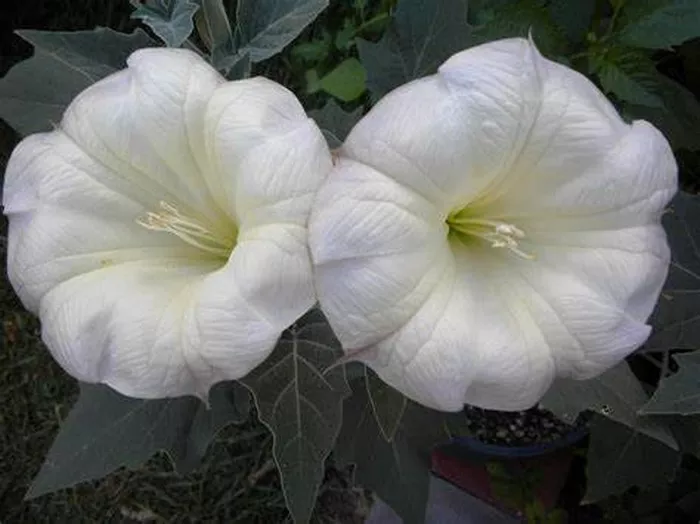Moonflowers (Ipomoea alba) are captivating and mystical plants known for their large, fragrant, white flowers that bloom at night, illuminating gardens with their ethereal beauty. Belonging to the morning glory family, these vining plants are relatively easy to grow, making them a popular choice for both novice and experienced gardeners alike. In this comprehensive guide, we will explore everything you need to know about cultivating moonflowers to add a touch of enchantment to your garden.
Understanding Moonflowers
Before delving into the specifics of growing moonflowers, it’s essential to understand their characteristics and requirements. Moonflowers are native to tropical and subtropical regions of the Americas, where they thrive in warm climates with ample sunlight. They are perennial in their native habitat but are often grown as annuals in cooler regions.
Moonflowers are vigorous climbers, capable of reaching heights of up to 15 feet or more in a single growing season. Their heart-shaped leaves provide a lush backdrop for the spectacular blooms that unfurl in the evening, releasing a sweet, intoxicating fragrance that attracts nocturnal pollinators such as moths and bats.
Selecting the Right Location
Choosing the perfect location for your moonflowers is crucial to their success. These plants require full sun to thrive, so select a spot in your garden that receives at least 6 to 8 hours of direct sunlight per day. Additionally, ensure that the soil is well-drained and rich in organic matter, as moonflowers prefer fertile growing conditions.
When planting moonflowers, consider providing them with a sturdy support structure to climb on, such as a trellis, fence, or pergola. This will not only help to showcase their sprawling growth habit but will also prevent them from sprawling across the ground and competing with other plants for space.
Starting from Seeds
Moonflowers are typically grown from seeds, which can be easily obtained from nurseries, garden centers, or online suppliers. Start by soaking the seeds in warm water for 24 hours before planting to soften the hard outer shell and encourage germination.
Sow the seeds directly into the garden soil once all danger of frost has passed and the soil has warmed up in the spring. Plant the seeds about ½ inch deep and space them 6 to 12 inches apart to allow ample room for growth. Keep the soil consistently moist but not waterlogged, as excessive moisture can cause the seeds to rot before they have a chance to sprout.
Caring for Moonflowers
Once your moonflowers have sprouted, proper care is essential to ensure healthy growth and abundant blooms throughout the growing season. Here are some tips for caring for your moonflowers:
1. Watering: Moonflowers have moderate water needs and prefer evenly moist soil. Water the plants deeply once a week, providing enough moisture to penetrate the root zone. Avoid overhead watering, as this can promote fungal diseases.
2. Fertilizing: Feed your moonflowers with a balanced, water-soluble fertilizer every 4 to 6 weeks during the growing season to promote vigorous growth and prolific flowering. Alternatively, amend the soil with compost or aged manure before planting to provide a steady supply of nutrients.
3. Pruning: To encourage bushier growth and more abundant blooms, pinch back the growing tips of your moonflowers when they reach a height of 12 to 18 inches. This will stimulate the development of lateral branches and result in a fuller, more compact plant.
4. Mulching: Apply a layer of organic mulch, such as shredded bark or straw, around the base of your moonflowers to conserve moisture, suppress weeds, and insulate the soil. Mulching also helps to regulate soil temperature, keeping it cooler in the summer and warmer in the winter.
5. Pest and Disease Control: Keep an eye out for common pests such as aphids, spider mites, and whiteflies, which can infest moonflowers and cause damage to foliage and flowers. If necessary, treat infestations with insecticidal soap or neem oil, taking care to follow the instructions on the product label. Additionally, practice good garden hygiene by removing debris and weeds that can harbor pests and diseases.
Harvesting and Enjoying Moonflowers
As the summer progresses, your moonflowers will reward you with a profusion of large, fragrant blooms that open in the evening and fade by morning. Take advantage of this enchanting display by spending time in your garden after sunset, savoring the beauty and fragrance of the flowers as they unfurl in the moonlight.
While moonflowers are primarily grown for their ornamental value, some gardeners may choose to harvest the seeds for propagation or decorative purposes. Simply allow the flowers to fade and form seed pods, then collect the pods once they have dried and turned brown. Crack open the pods to reveal the dark brown or black seeds inside, which can be saved and planted the following spring.
Conclusion
Growing moonflowers is a rewarding experience that allows you to bring a touch of magic and mystique to your garden. By selecting the right location, starting from seeds, and providing proper care, you can enjoy the sight and scent of these exquisite flowers throughout the summer months. Whether climbing a trellis, adorning a fence, or cascading from a hanging basket, moonflowers are sure to captivate the hearts and imaginations of all who encounter them.


